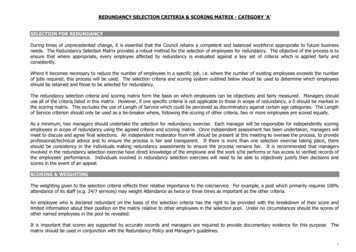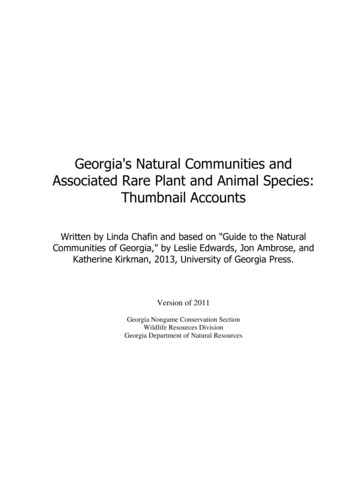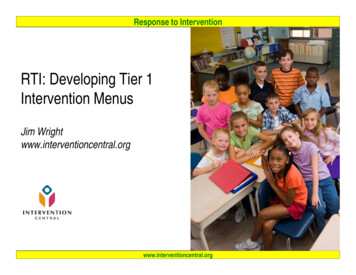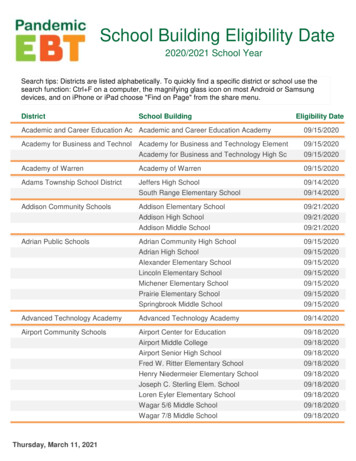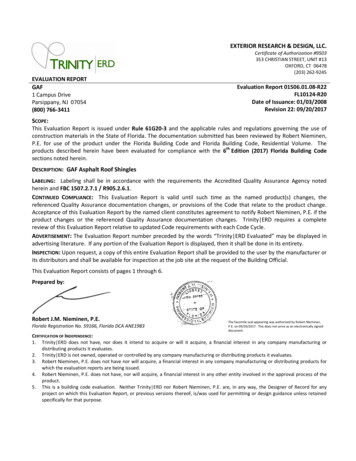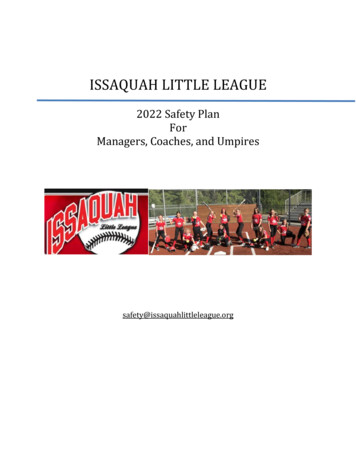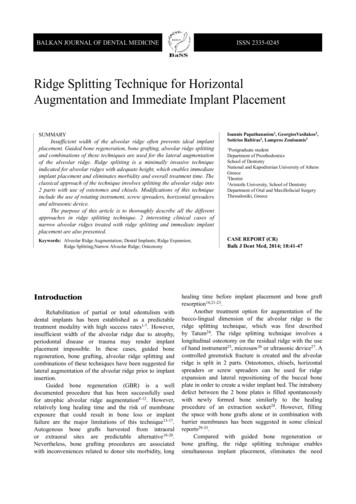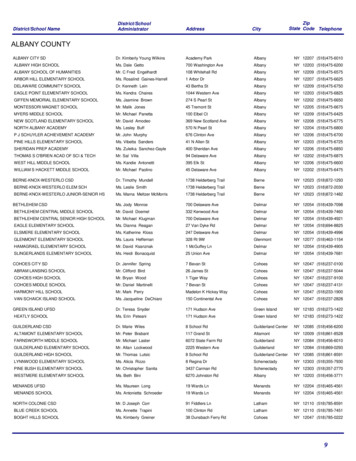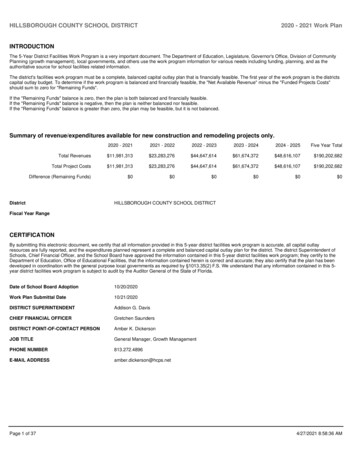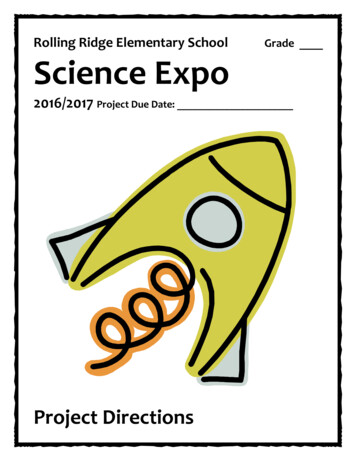
Transcription
Rolling Ridge Elementary SchoolGradeScience Expo2016/2017 Project Due Date:Project Directions
Table of ContentsParent Letter . 3Preparing Your Project . 4Science Expo Ideas . 6Resource List . 8Bibliography. 9Scientific Method Form . 10General Regulations . 112
Rolling Ridge Elementary SchoolScience ExpoRolling Ridge Science Expo: Wed., January 4th, 2017 at 6-7pm (gr. 1-6)in the Rolling Ridge Media CenterDistrict Science Fair: Set-up: January 30, 2017 – all dayJudging: January 31, 2017 – all dayAwards: February 1, 2017 – 6-7 pm (gr. 4-6)Dear Families,As you know, science, technology and engineering are basic skills expected by employers. AsTwenty First Century citizens, these students will also have to make some of the toughest decisionsof any generation, based on their understanding of emerging science and technology.Science expos involve students in the practices of science and engineering, requiring them to applythose skills to a topic of interest to them. Doing science is key to understanding science.Rolling Ridge is holding a science expo on January 4th, 2017. All students in grades 1-6 havebeen invited to participate. Hands-on scientific investigation and invention are the focus at ourparticular expo. Over a 4 to 6 week period, your child may design, test, analyze, and present aproject that uses scientific methods to solve a problem. The sky’s the limit! For grades 4-6, severalstudents will be chosen to move onto the District’s Science Fair on January 31st 2017.Please note that the bulk of the work will be done at home. Students will be given projectguidelines and timelines at school, and teachers will check in with them periodically. However,much of the work will be self-directed. Parents are encouraged to offer emotional support andreminders, but to allow children to do the projects by themselves. All students participating willreceive a ribbon and certificate of participation.We encourage you to review the following project directions for valuable information designedespecially for parents like you.Don’t hesitate to call or email with any questions. Individual due dates may vary per class so pleasecheck with your child’s teacher to make sure you get your project in on time. Thank you very muchin advance for your support!Sincerely,The Rolling Ridge Teachers and Administration3
The Rolling Ridge Teachers and Administration4
Preparing Your ProjectThe Scientific MethodStep One: Selecting A Topic/Problem/QuestionPick a topic that interests you. Remember, you will spend a lot of time on this topic. It will only befun if you want to learn about it. Where do you get ideas? Your interests or hobbies -science class topics -the Internet Parents, relatives, friends, visit the library Check out the idea list in this manual.Make a list of project ideas that interest you, and decide which topics can be tested. (For example,topics such as space or radiation might be interesting, but it would be difficult to set up anexperiment to test your research.)Step Two: ResearchFind out as much about your topic as possible. Encyclopedias will provide an overview of your topicgo beyond that and look everywhere to collect information. library internet zoo plant nurseries magazines science journals videos encyclopedias contact expertsOrganize your Research Report by keeping track of where you get your information. Write yourbibliography as you collect the information. (See format for bibliography on page .) IMPORTANT: If your experiment requires time to work, (plants need time to grow)think about starting the experiment process before your research is totally finished. Jump ahead tothe next stage and get started, then come back and finish your research.Step Three: HypothesisWhen you feel that you have enough information to really know your topic, then it’s time to make ahypothesis. Take the question you wrote earlier and turn it into an “If/then/ because” statementthat tells what you predict will be the result of the experiment and why.Example: If I give the plant more water, then it will grow taller because plants need water to grow.5
Step Four: ExperimentDesign an experiment to test your hypothesis. Make a step by step list of what you will do toanswer your questions. This is called an experimental procedure. Remember to select only onething to change (independent variable) in your experiment. You must tell how you are going tochange your variable, and how you are going to measure that. Also, in some experiments, you willneed a control. A control is a comparison. It will help you to show that the results were directlyrelated to your independent variable.Example: The control is that one plant will receive no additional water.Step Five: Journal and Research ReportThis journal will provide interested readers with a comprehensive look at your topic research. Itincludes a complete description of the problem and all information collected during your researchas well as a complete description of your experiment, materials used, data, and conclusions. Displayyour data as graphs, histographs, or charts. Don’t forget the one page summary called an abstract.Step Six: Preparing Your Display BoardNow that you have finished all of your hard work, it is time to show it all off. How you present yourexperiment and your findings is just as important as the experiment itself. Science Fair displayboards consist of three panels and are available at most office supply stores. If you cannot find one,see your teacher. Your written journal/report should be on the table, in front of the center panel.The traditional way to set up the board is: (variations are acceptable)Maximum size accepted is: 4 ft. wide x 2.5 ft. deep x 6.5 ft. tallAll projects must be pre-approved by teacher.Left panel: PROBLEM; HYPOTHESIS Center panel: TITLE,Right panel: RESULTS, DATAMATERIALS; MATERIALSANALYSIS; CONCLUSIONSMETHOD,EXPERIMENT/GRAPHS Student Name, (use photos,drawings, outlines)Project TitlePROBLEMResultsStudent NameData ns6
Science Expo IdeasThis list is not meant to be all-inclusive. Rather, it should be used to stimulate andencourage other ideas and possibilities on the part of the students. There is certainlylots to explore, lots to discover, and lots to investigate in a science expo. How does the angle of a ramp affect how quickly a ball will roll down it? Which chewing gum’s flavor lasts the longest? Which cleaning product is best for removing carpet stains? Which brand of diaper is the most absorbent? Which brand of paper towel is the strongest? Which brand of popcorn leaves the fewest unpopped kernels? Which fast-food burger contains the least grease? Which cereal will stay crispy the longest when placed in milk? Do suction cups stick equally well to all surfaces? What effect does the weight of a bat have on how far a ball can be hit? Which paper airplane will fly the farthest? Is an egg stronger one way or another? Compare the bonding strength of various types of glue. What effect does moisture have on various types of glue? Does the color of an object determine how much heat it absorbs from sunlight? Does temperature affect the strength of rubber bands? Which materials are the best insulators? What factors affect insulation? Which would melt first, ice wrapped with plastic wrap or with aluminum foil? Which freezes faster? Hot water or cold? Which will boil faster? Hot water or cold? What factors determine how long a candle will burn? Does the color of a liquid contribute to its ability to absorb heat? Does temperature affect how much salt or sugar can be dissolved in water? How does surface area affect the evaporation rate of liquids? What effect does temperature have on water evaporation? What factors affect the period of a pendulum?7
Do sunscreens really reduce the amount of ultraviolet radiation? Does temperature affect how well seeds sprout? Will soaking in water before planting help seeds sprout? What effect would freezing have on how well seeds sprout? Does soil acidity affect how well seeds sprout? Does the depth a seed is planted affect its ability to sprout? Does the type of water source used affect seed germination? Is plant growth affected by how closely together the seeds were planted? Do plants grow better with tap water or distilled water? What is the effect of different colors of light on plant growth? Is plant growth affected by exposure to ultraviolet light? Does sound have any effect on plant growth? Does music? What effect does different types of music have on plant growth? Which additive is the best for preserving cut flowers? (salt, aspirin, 7-up, etc.) Does the angle that the stalk is cut have any effect on the life of cut flowers? What effect does salt water have on plant growth? Would soapy water harm or help seed sprouting and/or plant growth? What would be the effect on plants of using liquids such as milk, Coke, or juice instead of water? How animals grow Animals and their young Animals in our lives Endangered animals What do roots, stems, and leaves do? Growing and caring for flowers The food we get from plants How are some plants dangerous? Properties of matter How does matter change? Work, force, and energy Pushing and pulling8
Resource ListBooks100 Amazing Make-It-Yourself Science Fair Projectsby Glen Vecchione50 Nifty Science Fair Projectsby Carol Amato,et al.Kidsource: Science Fair Handbookby Danna VothMore Blue Ribbon Science Fair Projectsby Maxine Haren IritzEnvironmental Science: 49 Science Fair Projectsby Robert L. BonnetExperiment With Plantsby Monica BylesThe First Timer’s Guide to Science Fair Projectsby Q.L. PearceBotany: 49 Science Fair Projectsby Robert L. BonnetThe Complete Handbook of Science Fair Projectsby Julianne B. BochinskiMagic Mud and Other Great Experimentsby Gordon PenroseJanice VanCleave’s Spectacular Science Seriesby Janice VanCleave175 More Science Experiments to Amuse and Amaze Your Friendsby Terry Cash200 Illustrated Science Experiments for Childrenby Robert J. BrownPAGE 25Adventures With Atoms and Molecules: Chemistry Experiments for Young Peopleby Robert C. Mebane50 Terrific Science Experimentsby Lisa Taylor MeltonScience for Youby Bob BrownMr. Wizard’s 400 Experiments in Scienceby Don HerbertDr. Zed’s Zany Brilliant Book of Scienceby Gordon PenroseWeb p://www.sciencebuddies.org/9
Bibliography A bibliography is a listing of the books, magazines, and Internet sources that you use indesigning, carrying out, and understanding your science expo project.BooksFormat:Author's last name, first name. Book title. City of publication: Publishing company, publication date.ExamplesToomer, Jean. Cane. Ed. Darwin T. Turner. New York: Norton, 1988.Boorstin, Daniel J. The Creators: A History of the Heroes of the Imagination. New York: Random, 1992.Encyclopedia & DictionaryFormat:Author's last name, first name. "Title of Article." Title of Encyclopedia. Date.Examples"Azimuthal Equidistant Projection." Merriam-Webster's Collegiate Dictionary. 10th ed. 1993.Pettingill, Olin Sewall, Jr. "Falcon and Falconry." World Book Encyclopedia. 1980.Magazine & Newspaper ArticlesFormat:Author's last name, first name. "Article title." Periodical title Volume # Date: inclusive pages.ExamplesKalette, Denise. "California Town Counts Down to Big Quake." USA Today 9 21 July 1986: sec. A: 1.Kanfer, Stefan. "Heard Any Good Books Lately?" Time 113 21 July 1986: 71-72.Website or WebpageFormat:Author's last name, first name (if available). "Title of work within a project or database." Title of site, project, ordatabase. Editor (if available). Electronic publication information (Date of publication or of the latest update, and nameof any sponsoring institution or organization). Date of access and full URL .Note: If you cannot find some of this information, cite what is available.ExamplesLancashire, Ian. Homepage. 28 Mar. 2002. 15 May 2002 http://www.chass.utoronto.ca:8080/ ian/ .Levy, Steven. "Great Minds, Great Ideas." Newsweek 27 May 2002. 10 June 2002 http://www.msnbc.com/news/754336.asp .10
Scientific Method FormQuestion: What do you want to find out? Make observations. Look at yourenvironment. Look at the materials you have available.Hypothesis: What do you think you’ll find out? What do you predict the outcome ofthe experiment will be?Experiment: How will we find out? (List step by step)Results: What actually happened?Conclusion: What did we learn? Analyze your results and compare actual results withyour hypothesis. Decide whether or not your hypothesis was supported. Think aboutfurther research. Write up your findings to share with other scientists.11
General Regulations1.Human parts other than teeth, hair, nails and liquid tissue slides (properly fixed and acquired)may not be displayed.2. Photographs or other visual presentations of any surgical techniques, dissections, autopsies,and/or laboratory techniques depicting vertebrae animals in other than normal conditions maynot be displayed on the student’s exhibit table, but may be contained in accompanyingnotebook.3. No project may use consumable alcohol, tobacco, or illegally obtained narcotics and/orcontrolled substances. This includes surveys on projects that compare the use of the abovesubstances; (e.g. smokers versus non-smokers).4. No living or non-living plants, mold, viral, or bacterial materials may be on display.5. Live animals may not be displayed during the Expo.6. Glass containers of any kind may not be used.7. Electrical materials must be in keeping with standard safety laws and practices. Displays will beinspected for compliance with items listed below:a. Wiring must be properly insulated and fastened.b. Wiring switches and metal parts of high voltage circuits must be located out of reachof observers and must include an adequate overload safety device.c. High voltage equipment must be shielded with the grounded metal box or be cagedto prevent accidental contact.8. Open flames will not be permitted.9. All experimental work must be done by students. Adults may supply materials, advice, andconsultation.12
The Complete Handbook of Science Fair Projects by Julianne B. Bochinski Magic Mud and Other Great Experiments by Gordon Penrose Janice VanCleave's Spectacular Science Series by Janice VanCleave 175 More Science Experiments to Amuse and Amaze Your Friends by Terry Cash 200 Illustrated Science Experiments for Children by Robert J. Brown PAGE 25
